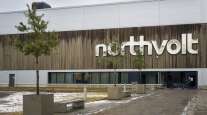Associated Press
San Francisco Tests Out Driverless EV Shuttle

[Stay on top of transportation news: Get TTNews in your inbox.]
SAN FRANCISCO — First came the robotaxis. Then the driverless buses arrived.
San Francisco has launched an autonomous shuttle service less than a week after California regulators approved the expansion of robotaxis despite traffic and safety concerns.
The free shuttle will run daily in a fixed route called the Loop around Treasure Island, the site of a former U.S. Navy base in the middle of San Francisco Bay. The Loop makes seven stops, connecting residential neighborhoods with stores and community centers. About 2,000 people live on the island.
The all-electric vehicle, which doesn’t have a driver’s seat or steering wheel, is staffed with an attendant who can drive the bus with a handheld controller if necessary. The county is offering the shuttle service as part of a grant-funded pilot program to assess how autonomous vehicles can supplement the public transit system.
“Having the attendant on board makes everyone feel comfortable,” said Tilly Chang, executive director of the San Francisco County Transportation Authority. “This is just a demonstration for now to see, what does it look like and how does it work to have a driverless shuttle in a low-volume, low-speed environment?”

An attendant with a remote control unit stands at the ready inside the driverless shuttle. (Terry Chea/Associated Press)
San Francisco is one of a growing number of cities worldwide that are testing the safety and potential of self-driving vehicles to transform public transportation.
The shuttles are operated by Beep, an Orlando, Fla.-based company that has run similar pilot programs in more than a dozen U.S. communities, including service at the Miami Zoo, Mayo Clinic and Yellowstone National Park.
BEEP IN ORLANDO: Driverless EV shuttle loops through downtown
“These shuttles are built for first-mile, last-mile, short connectivity routes. They’re not intended to take the place of a bus system,” said Beep project manager Shelley Caran. “The autonomous vehicle will have a better reaction time than a human and it will offer a more reliable service because they won’t be distracted.”
During a test ride Aug. 16, the shuttle drove slowly and cautiously in autonomous mode. An attendant manually steered the vehicle around a utility truck that blocked part of the road.
“I didn’t feel unsafe,” said Dominic Lucchesi, an Oakland resident who was among the first to ride the autonomous shuttle. “I thought that it made some abrupt stops, but otherwise I felt like I was riding any other bus for the most part.”
The boxy shuttle, which can sit up to 10 passengers, will operate 9 a.m. to 6 p.m. every day and circle the Loop every 20 minutes. The city has two shuttles — one can charge while the other ferries passengers.
The autonomous shuttle pilot project was launched after the California Public Utilities Commission voted to allow two rival robotaxi companies, Cruise and Waymo, to offer around-the-clock passenger service in San Francisco.
The approval came despite widespread complaints that the driverless taxis make unexpected stops, cause traffic backups and block emergency vehicles. On Aug. 16, the city asked the commission to pause the robotaxi expansion.

Ryan Manthir of Shell Global Solutions and Michael Grahe of Navistar discuss the future of the internal combusion engine. Tune in above or by going to RoadSigns.ttnews.com.
Cruise, a subsidiary of General Motors, reported on social media that one of its robotaxis was hit by a city firetruck Aug. 17, sending one passenger to the hospital.
Experts don’t anticipate the same problems with driverless buses because they’re expected to be staffed with drivers or attendants for the foreseeable future.
“Trained operators are going to be required even as we increase automation,” said Nikolas Martelaro, autonomous vehicle researcher at Carnegie Mellon University. “So the question there may not be how worried should someone be about losing their job versus what should they be thinking about the potential training that’s required.”
Autonomous driving technology could make buses safer, but requiring drivers or attendants on board could undermine one of their perceived advantages: reduced labor costs.
“We still have to find a market for them,” said Art Guzzetti, vice president at the American Public Transportation Association. “We’re doing it to make the trip better, more efficient, not to take the worker’s job.”
Want more news? Listen to today's daily briefing below or go here for more info:




